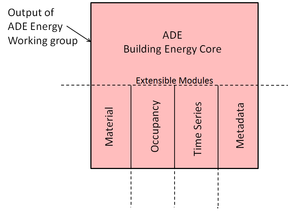Difference between revisions of "2014 KA Minutes of the Workshop"
| Line 129: | Line 129: | ||
* ADE Energy implementation form | * ADE Energy implementation form | ||
| + | [[File:ADE_Energy_Structure.bmp|right|300px|ADE_Energy_Structure]] | ||
Three different forms of ADE Energy implementation were brought up: | Three different forms of ADE Energy implementation were brought up: | ||
1- a uniform ADE Energy, integrating all developments of the WG | 1- a uniform ADE Energy, integrating all developments of the WG | ||
Revision as of 16:43, 4 November 2014
2nd Workshop CityGML EnergyADE - Karlsruhe, 30th of October 2014
- Host: EIFER Karlsruhe, Germany
- List of participants
Next Steps - TODO List
| WHAT | WHO | WHEN |
|---|---|---|
| Provide Feedbacks on the current UML Schemas (see Community Portal) | ALL participants | Nov 2014
|
| Finalize the ADE Energy UML Schema, based on the different Feedbacks | HFT (Bruse, Nouvel) | 1st week Dec 2014
|
| Write ADE Energy XSD Schema | EIFER (Nichersu), CSTB (Tournaire) | Dec 2014
|
| Implement XSD Schema in Simulation tool/platform Write test CityGML file |
RWTH Aachen, EPFL, SINERGIS, CSTB, TUM, HFT | Jan - Feb 2015
|
| Start simulation based on test CityGML file Iterative process with feedbacks |
RWTH Aachen, EPFL, SINERGIS, CSTB, TUM, HFT | Mar - Apr 2015
|
| Come to next workshop with results | ALL participants | Mar - Apr 2015
|
Presentations and Minutes
| TOP 1: ADE Energy, Motivations and requirements
Jean-Marie Bahu (EIFER Karlsruhe) Presentation: Energy ADE Workshop - Introduction |
| TOP 2: Energy Aspects of the INSPIRE Building Model
Dr. Gerhard Gröger (University of Bonn - Geoinformatics) Presentation: Energy Aspects of the INSPIRE Building Model
R. Nouvel: is there some risks of redundancy between the ADE INSPIRE developped currently (in particular by Mr. Kolbe) and our ADE ENERGY?
|
| TOP 3: Material module for ADE Energy
Joachim Benner and Karl-Heinz Haefele (KIT Karlsruhe) Presentation: Proposal of a Material Extension for the EnergyADE
K.H. Haefele: Window may be considered as a generic construction. Is an additional window model required?
K.H. Haefele: Should be “cost” taken into account in UML? How it should be integrated? (All costs are here considering, including financial costs, grey energy, emission cost needed etc.)
M. Petit: in costs, currency and unit parameters could be combined in a unique parameters.
Same consideration that for costs. This is not specific to materials.
K.H. Haefele: there are some risks that the texture displays in an uncorrect orientation. Should we add an explicit visualization information?
R Nouvel: In the current ADE Materials version of KIT (like in gbXML), Thickness is part of the material parameters. In most simulation models and some international formats (ifc), thickness is associated with layers while materials contain only parameters proper to it (conductivity, volumetric capacity etc.). Could we rather consider this modelling way. |
| TOP 4: Building Physics module
Romain Nouvel (HFT Stuttgart) Presentation: Report of the Activities of the Building Physics Group |
| TOP 5: Occupancy module for ADE Energy
Jean-Marie Bahu (EIFER Karlsruhe) Presentation: Report of the Activities of the Building Occupants Group
L. Giovanni: What represent the occupancy schedules?
ACTION (Nov. 2014): R. Kaden (TU Munchen) will share his model of Time-Depending Data Type on the Wiki. After discussion and finalization, this model will be used for the schedule definition.
|
| TOP 6: Energy System module for ADE Energy
Romain Nouvel (HFT Stuttgart) Presentation: Report of the Activities of the Energy Systems Group
Someone: Which energy system parameters should be standardized in the ADE Energy?
|
| TOP 7: Metadata module for ADE Energy
Volker Kraut (M.O.S.S. Taufkirchen) Presentation: Report of the Activities of the Metadata Group
ACTION (until next workshop): All participants of the other Working groups should supply a list of required metadata for specific parameters.
|
Open discussion and next step definition
- ADE Energy implementation form
Three different forms of ADE Energy implementation were brought up: 1- a uniform ADE Energy, integrating all developments of the WG 2- a mandatory ADE Energy core on one side, and on the other side an optional extended ADE Energy (inspired from the Core3D and Extended3D from INSPIRE) 3- an ADE Energy core linked to several ADE Energy modules corresponding to different attributes categories (i.e. time-series, material, occupancy and energy systems).
The last scenario was accepted. The ADE Energy core correspond to the Building Physics Module, which sets a data structure to link the different modules. The ADE Energy modules will be integrated in the same UML schema ADE Energy, in modular way. Some later extensions of each of this module outside the "Building Energy" theme will be possible (e.g. later creation of a ADE Materials or ADE Occupancy).
- Levels of Detail covered by the ADE Energy
J.M. Bahu prefered to focus first on the main application of this ADE Energy: the building modelled in LoD2.
R. Nouvel reported that the ADE Energy has been from the beginning developed as flexible as possible, potentially compatible with all CityGML Levels of Details (LoD1 to LoD4). Then he suggested to define a UML schema covering all LoDs, and wait for some feebacks from the test phase.
This last proposition found finally consensus.
- Window definition
RWTH and HFT Stuttgart suggested to define a semantical window object (related to a shading object) in a similar way that for ThermalBoundarySurface. Without LoD3 or more, the position of the windows is unknown, only the window surface area is relevant.
